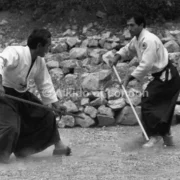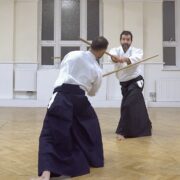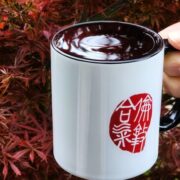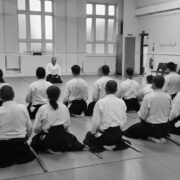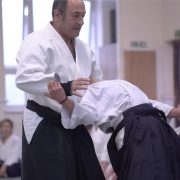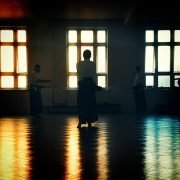AIKIDO SENSEI AND SEMPAI…
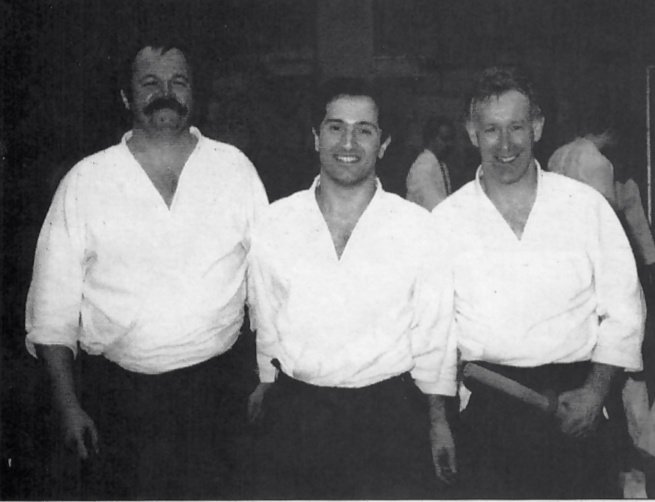

In 1976 Chiba Sensei returned to Japan, after having spent ten years propagating Aikido in the United Kingdom. From what I can gather, Chiba’s very martial approach left the majority of Hombu Aikidoka somewhat dismayed. This distinct ‘lack of moral fibre’ – no, let us be charitable and say their highly developed sense of self-preservation – did not extend to one Ichiro Shibata. Shibata was immediately taken by Chiba Sensei’s Aikido. Even though, at the time, Shibata was already a very capable and respected junior teacher, he applied himself vigorously to following Chiba’s distinctive method.
As a consequence, we followers of Chiba’s Aiki are fortunate enough to have two Shihan upon whom we can focus our studies. Shibata, through his humour and approachable manner, has made himself almost a stepping-stone for those serious and senior aikidoka who wish to pursue the Chiba ideal.
Despite never having practised Aiki Ken (sword) or Aiki Jo (staff) prior to meeting Chiba Sensei, Shibata has, through much hard work, become a terrifyingly proficient weapons master. His dynamic and uncompromising – approach to weapons training is totally in line with Chiba Sensei’s own regimen. To witness these two great masters practicing weapons together is indeed an awesome experience. In the Jo and Ken work, Chiba and Shibata generate a martial spirit and form that is pure Budo, or perhaps it’s more akin to the original Bujutsu…l’m not sure, but that it is something very special is without question!
These two most pragmatic of Aikido Shihan are working closely together to develop a direction in Aikido that is both innovatory in outlook, traditional in its values. Shibata has firmly pinned his ‘colours’ to Chiba’s mast, so to speak, and has, I know, been an invaluable asset to him in his formulation of Aiki weapons.
My first encounter with Shibata Sensei was in 1982 at the British Aikido Federation Summer School in Chester. His presence at that course brought back a host of memories for we ‘old’ Chiba types. Being called out as uke for Shibata caused more than just a frisson down the spine – it put one’s adrenaline into ‘over- drive’. l was fortunate enough (I think that’s the right phrase) to be called out two or three times. Although his speed and power were breathtaking (sometimes literally), and his martial potential quite terrifying – his control was superb. His main uke that week was Terry Ezra, even then one of the U.K.’s most talented Aikidoka. My lasting memory of Terry as uke was of him striking Shibata Sensei with oi-tsuki (lunge punch) in the belly, and doing it harder each time. Shibata not only absorbed Terry’s strikes with ease, he actually threw him by just expanding his belly into Terry’s fist. Awesome!
lt is my earnest hope to have Shibata Sensei again in Durham for a course. When I do l’Il let you know through Fighting Arts International – and if you want to come along and train, you will, of course, be most welcome.
In the United Kingdom, Chiba Sensei has a great many followers. However, few of them can claim to have trained under him during his ten-year stay in this country. Sensei’s early days were spent in my own part of the world, the north east of England. This came about because his sponsor, Mr.Logan, was a businessman based in the city of Newcastle upon Tyne. Chiba’s time spent in this area was frugal indeed by the standards of today. He was a young man, and perhaps not a very worldly-wise one at that, with little money, in an alien culture, and a mission to fulfill against all odds.

An inauspicious beginning that might have dented the resolve of a lesser man. Chiba sensei, with the assistance of a few good men in Sunderland, had the determination and strength of character to make these formative years a solid base from which to launch his own, quite singular, style of Aikido. This style, which has spawned many a strong dojo, not only in Great Britain but also in the United States, has made Chiba a legend in his own time.
During his first two years in the north-east, Chiba Sensei promoted his first group of Shodans (1st degree Black Belt) in this country – namely Pat Butler, Fred Jenkins and my own teacher, Ron Myers. These three men gave much in their own individual ways to the establishment of Chiba’s Aikido in the 1960s. But more to the point, they helped him to survive.
Regrettably, Pat passed away in 1994, and Fred and Ron are no longer active in Aikido. Therefore I believe that Chiba Sensei’s most senior follower – still practising in the U.K. – is Mr. William Smith.

